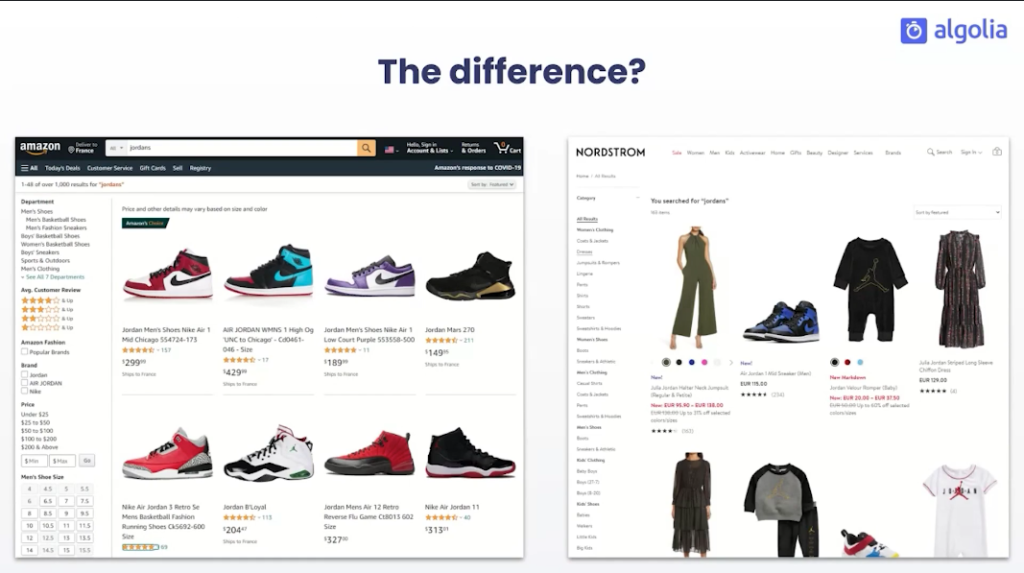Brands are always looking to create meaningful connections with people. But, it can be a complicated endeavor—it requires understanding intent in the moment, personalized navigation, search and recommendations or offers.
In our latest webinar What Makes Creating Meaningful Experiences for Your Shoppers So Hard?, Gaetan Gachet, Chief Strategy Officer at Algolia presented on what shoppers are looking for and how to improve their experience using AI. His presentation was followed by a panel with Chris Hardisty, SVP Ecommerce at Clarks, Kristin Smith, SVP Digital at Hanna Andersson and Alex Richardson, Chief Technology and Digital Officer at Frederic Fekkai Brands.
Read the full webinar’s recap below or watch the replay here.
(Presentation Recap) Creating Meaningful Shopper Experiences
Despite all the pandemic’s challenges, ecommerce saw incredible growth this past year. It’s truly a once-in-a-company’s-lifetime industry opportunity to capture new market share, and the pandemic cracked ecommerce wide open for this. Amazon and Etsy, a.k.a. digital natives, were better equipped initially to handle such an abrupt and large scale shift in demand because they have invested so much in customer experience over the years. Other companies who aren’t as well-versed in digital (or don’t have as abundant of resources) struggle to compete. AI and machine learning could be the answer to their problem.
Customer Experience + AI/Machine Learning
Retailers know customer experience is critical—it’s been a hot topic not only during the pandemic, but also for the last 10 years. Despite this general awareness, conversion rates overall have not improved much—there is clearly something the retail industry has overlooked.
Reports from shoppers show that search and navigation are the most important UX elements—they want to find products quickly and seamlessly. Amazon mastered these typically problematic UX components thanks to their army of engineers who integrated AI and machine learning into their search and navigation experience from the start. Amazon’s search conversion rate is 12.9% compared to Walmart, Etsy and Best Buy with conversion rates around 3% each.
What Does AI/Machine Learning Look Like in the Real World?
To understand how AI and machine learning make a difference in website navigation, Algolia uses the example of searching for ‘Jordans’ on Amazon versus on Nordstrom. The result is as follows:

Amazon’s algorithm can pick up that searching ‘Jordans’ means the user is looking for the shoe, while Nordstrom’s results are not as relevant or sophisticated, and also shows the designer Julia Jordan as well as other non-shoe products. This makes the shopper experience more difficult, lengthy and possibly frustrating. As Gachet puts it, “The cost of [customers] switching in the online world is zero” so it’s important to have a sophisticated search engine. While most companies don’t have the army of engineers that Amazon does, there are still economic and efficient ways to utilize AI for differentiation and enhancement of your customer experience.
While there are options that help companies create sophisticated search engines with AI, they all have their flaws. Creating an open source software requires a large team of engineers and is time consuming, while pre-packaged solutions have limited flexibility and differentiation.
Algolia’s approach is to apply the principles from Headless Commerce to AI, providing purpose built AI models packaged into APIs for developers to build upon.
(Panel Recap) The Future Of Retail Tech
After Gachet’s presentation, Hardisty, Smith and Richardson joined for a panel. They shared best practices for digital innovation, attributes to focus on and the future of technologies in retail.
New Innovations
Over the last year, companies have been working on new ways to digitally connect with consumers. As Algolia pointed out, more brands are creating content outside of the transactional relationship. If customers are not in a buying mood, they can still get advice or learn about something related to the products, targeting the entire funnel of the customer journey.
Some great examples came straight from our panel:
- Clarks: They created a back-to-school virtual fitting over Zoom where parents and children worked with a customer care representative to find the right fit for their school uniforms.
- Fekkai Brands: They replatformed and redesigned, including a personalized hair quiz to help customers determine which products best fit their needs. The quiz asks questions, allows the customer to submit a photo of their hair and uses location to determine what environmental factors might impact the customer’s hair.
Pro tip: While moving quickly to adapt to new technologies and innovation is important, don’t forget the other factors at play, like the time of year, company maturity and prioritizing projects with the biggest impact.
Loyalty, Loyalty, Loyalty!
While conversion is important, the metric everyone should wake up and worry about is loyalty. Are you thoughtfully enabling your customers to come back and make repeat purchases or refer your products to their network? All digital innovation needs to create repetitive sales that are scalable.
AR in Retail
While the buzz-worthy AR/VR might be the future hot technology, not all retail sectors are ready for it: home furnishings and beauty are farther along in development than fashion and footwear.
Moving Towards a Cookieless World
As we move towards a cookieless new order, retailers will have to adapt and find new ways to gather first-party data. Although the new data restrictions may very well make customer acquisition even more challenging, they also present an opportunity to double down on loyalty. Brands will need to develop creative ways for users to log in and give their information, thinking about it from the perspective of what the customer gets out of giving their information to you.
We’re approaching a new phase of the pandemic, a light at the end of the tunnel where normal life may be able to resume, but our industry is forever changed. We’ve learned a ton about our customers, but we need to utilize those learnings in thoughtful ways to ensure we’re always keeping the customer top of mind. AI, machine learning and meaningful experiences can do just that. CommerceNext is here to help you stay on top of it all and navigate through it.
Related Posts
-
Use Customer Experience To Improve Your 2021 Gifting Strategy
With ecommerce sales at an all-time high, retailers can expect…
-
Session Recap: Why Marketing Needs To Own The Customer Journey
With more places for customers to engage with your brand…
-
MSS Spotlight: Analyzing the Impact of SMS on the Customer Journey
Mobile is one of the fastest growing channels for ecommerce,…




